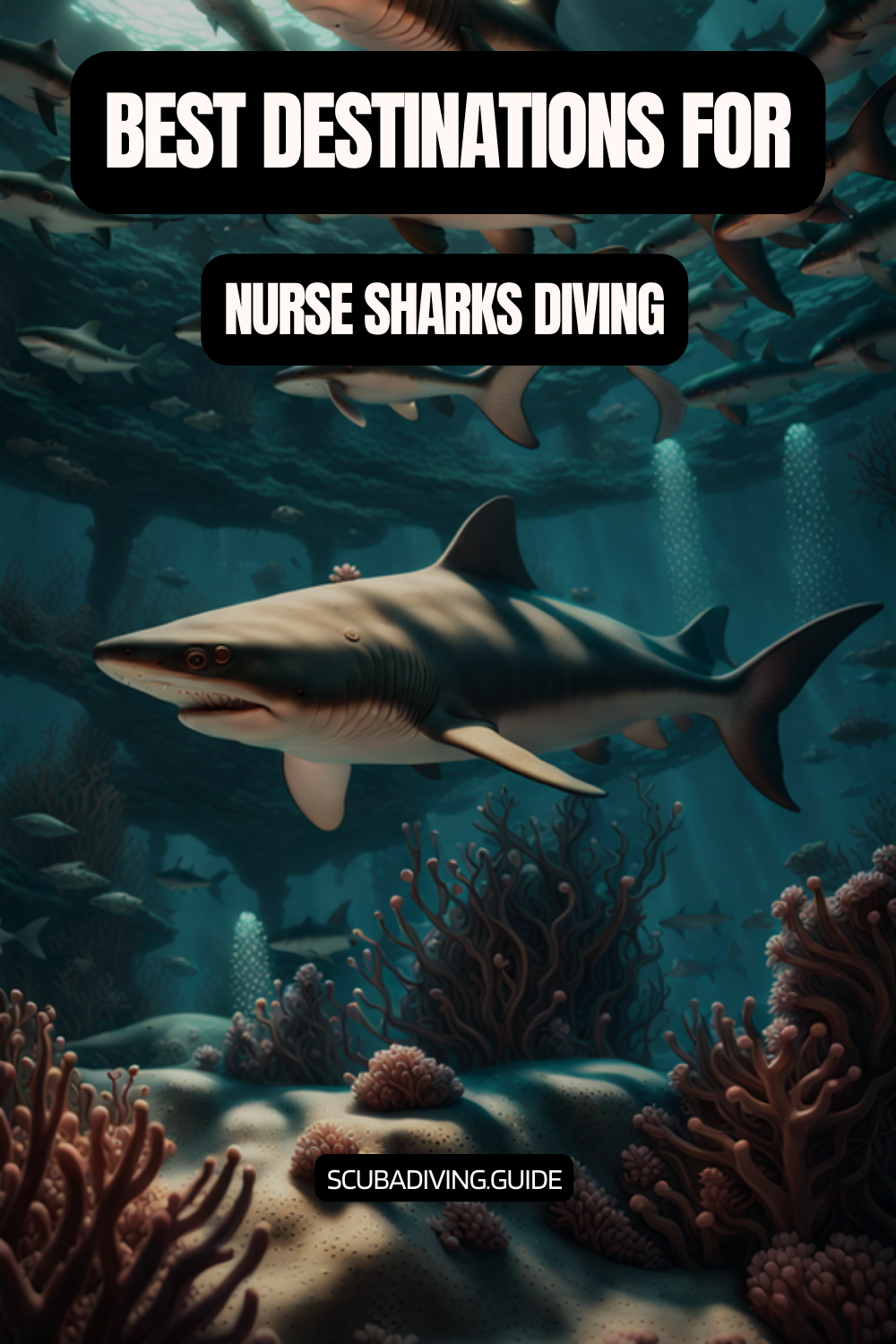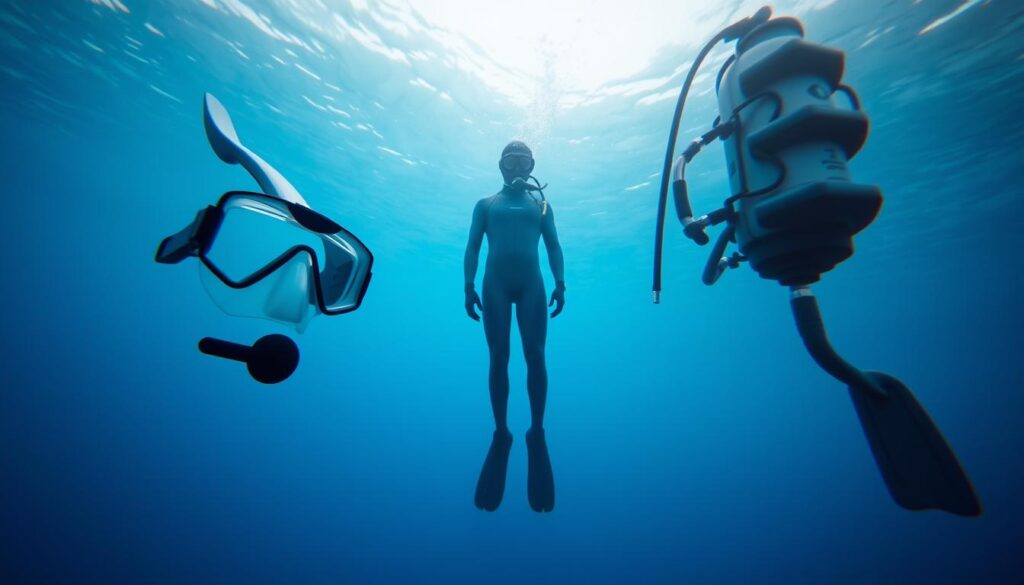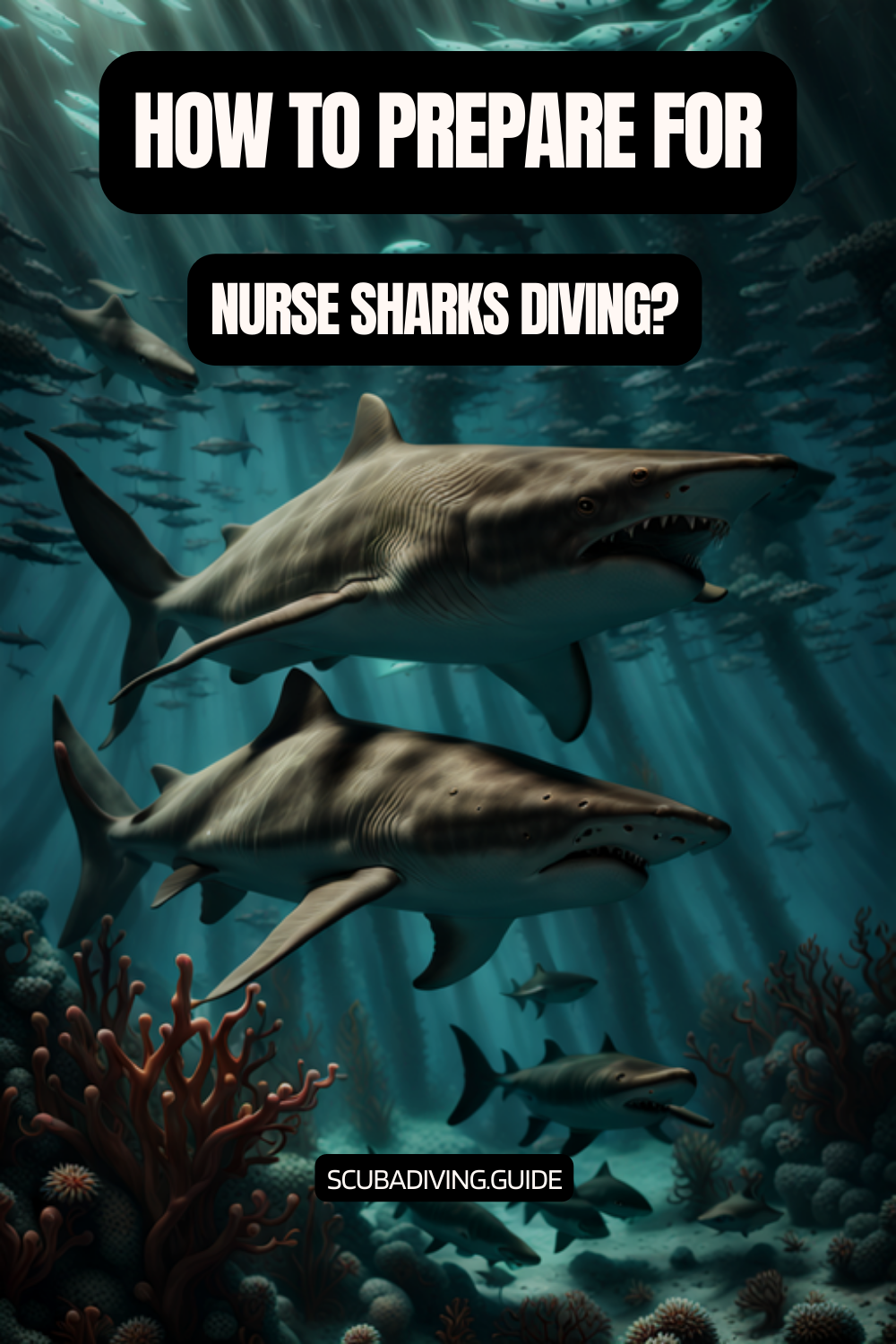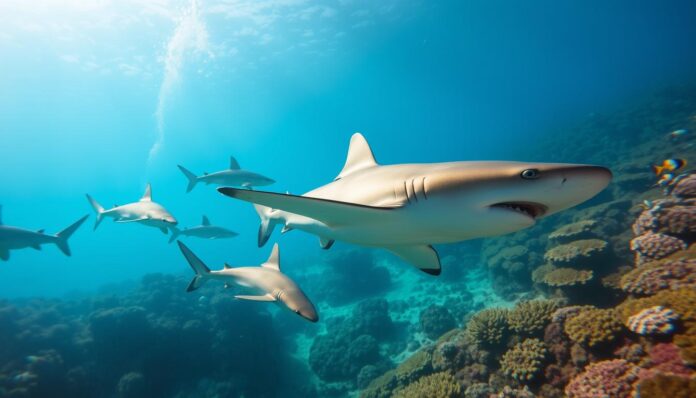Did you know nurse sharks are common in the Caribbean? You can see them up to 90% of the time in some places. Scuba diving with them is an amazing adventure. It lets you see the colorful Caribbean underwater world.
Caribbean diving is a special experience for shark fans and marine life lovers. Nurse sharks are calm, so you can watch them closely. You can dive in places like Belize and the Bahamas. It’s a trip you’ll never forget.
Key Takeaways – Diving with Nurse Sharks
- Nurse sharks are prevalent in Caribbean waters
- Diving locations offer high-probability shark encounters
- These sharks are known for their gentle behavior
- Multiple Caribbean destinations provide unique diving experiences
- Professional dive centers ensure safe and educational interactions
Introduction to Nurse Sharks and Their Habitat
Dive into the fascinating world of nurse sharks, remarkable marine wildlife that inhabit the warm Caribbean waters. These unique creatures represent an incredible part of marine ecosystems, playing a key role in nurse shark conservation efforts.
The common Atlantic nurse shark, scientifically known as Ginglymostoma cirratum, thrives in tropical marine environments. These fascinating predators are most abundant in the western Atlantic Ocean and Caribbean Sea, ranging from Brazil to North Carolina.
What are Nurse Sharks?
Nurse sharks are distinctive bottom-dwelling sharks with several remarkable characteristics:
- Maximum length of 3.5 to 4 meters (11.5–13 feet)
- Reach sexual maturity at 210–230 cm
- Born at lengths of 26–30 cm
- Capable of doubling size within first year
“Nurse sharks are among the most docile shark species, making them fascinating subjects for marine wildlife enthusiasts.”
Where to Find Nurse Sharks in the Caribbean
These incredible marine creatures inhabit diverse underwater landscapes, from shallow nearshore environments to depths of up to 230 feet. Their preferred habitats include:
- Coral reefs
- Rocky seafloors
- Seagrass meadows
- Sandy coastal areas
| Habitat Characteristic | Nurse Shark Preference |
|---|---|
| Depth Range | Intertidal to 70 meters |
| Water Temperature | 25°C to 34°C |
| Salinity | 31-38 ppt |
Interestingly, 72.7% of nurse shark breeding events occur in shallow waters, with 90.9% happening inside Marine Protected Areas. The IUCN Red List currently categorizes the Atlantic nurse shark as ‘Vulnerable’, underscoring the importance of continued conservation efforts.
Why Go Scuba Diving with Nurse Sharks?
Diving with nurse sharks is an amazing adventure. It combines exciting shark encounters with learning opportunities. These gentle creatures offer a unique and unforgettable experience.
Nurse sharks are great for underwater photography and learning. Their calm nature makes them perfect for photographers and marine lovers. They offer close interactions with these fascinating creatures.
Unique Diving Experience
In Caribbean waters, divers can have amazing shark encounters with nurse sharks. These slow-moving creatures live in depths from 3 to 40 feet. They provide memorable and accessible experiences.
- Observe nurse sharks resting in reef crevices
- Capture stunning underwater photography moments
- Experience close interactions with peaceful marine predators
Educational Opportunities
Nurse sharks offer valuable insights into marine ecosystems. Their behavior and role in the ocean make them great for learning about marine conservation.
| Characteristic | Details |
|---|---|
| Average Swimming Speed | 1.5 mph (2.4 kph) |
| Hunting Speed | Up to 25 mph |
| Habitat Depth | 3-40 feet |
| Mating Season | May to July |
“Nurse sharks represent a perfect blend of marine wonder and tranquil exploration for divers seeking meaningful underwater experiences.”
Nurse sharks are known for their peaceful nature. They have only 9 recorded non-fatal, unprovoked attacks. Their home in warm, shallow waters near coral reefs makes them easy for divers to access.
Best Caribbean Destinations for Nurse Shark Diving
Caribbean diving is home to some of the most amazing nurse shark encounters. If you’re looking for a unique marine experience, these spots are unforgettable.

Belize: A Shark Lover’s Paradise
Ambergris Caye in Belize is a top spot for nurse shark fans. The waters around San Pedro offer a great alternative to the Bahamas, with incredible sea life.
- Prime diving location near San Pedro
- Consistent nurse shark sightings
- Ideal for both novice and experienced divers
The Bahamas: Shark Encounter Central
The Bahamas is the best place for diving with nurse sharks. Divers get many chances to see these creatures in their home.
“The Bahamas offers an unparalleled underwater experience with nurse sharks that will leave you breathless!” – Marine Expedition Magazine
Grand Cayman: Underwater Exploration
Grand Cayman has amazing dive spots for nurse shark sightings. The USS Kittiwake shipwreck at 251 feet is a unique underwater world.
- Over 365 dive sites annually
- Diverse marine ecosystem
- Exceptional visibility and conditions
Each place gives a special view of nurse sharks, making diving in the Caribbean a memorable adventure for all.
Best Destinations for Diving with Nurse Sharks
Diving enthusiasts seeking unforgettable encounters with nurse sharks have a variety of destinations to choose from around the world. These global locations offer unique opportunities to witness these majestic creatures in their natural habitats. Here is a curated list of some of the best destinations for diving with nurse sharks, categorized by regions:
Asia:
- Maldives: The crystal-clear waters of the Maldives provide excellent visibility for diving with nurse sharks. Head to dive sites like Maaya Thila or Fish Head, where nurse sharks are commonly spotted gliding gracefully through the reef.
- Philippines: The Philippines is renowned for its incredible biodiversity. Destinations like Tubbataha Reefs Natural Park and Apo Reef Natural Park are known to have nurse sharks among the myriad of marine life found in these protected areas.
- Mozambique: The warm waters of Mozambique offer fantastic opportunities for nurse shark encounters. Dive sites like Tofo Beach and Ponta Do Ouro are frequented by nurse sharks, providing thrilling diving experiences.
- Seychelles: The stunning islands of the Seychelles are home to nurse sharks. Praslin Island and Sainte Anne Marine National Park are popular spots for diving with these gentle creatures while exploring the vibrant coral reefs.
Caribbean:
- Belize: The crystal-clear waters of Belize’s Barrier Reef attract divers from around the world. Sites like Ambergris Caye and Turneffe Atoll are known for their nurse shark populations, allowing for unforgettable encounters.
- Bahamas: The Bahamas is famous for its nurse shark encounters, particularly at sites like Tiger Beach and Bimini. Dive with these magnificent creatures and witness their peaceful demeanor in the turquoise waters.
- Costa Rica: Costa Rica offers exceptional diving opportunities along its Pacific and Caribbean coasts. Places like Isla del Coco and Tortuga Island are known for nurse shark sightings, allowing for remarkable underwater experiences.
- Honduras: The Bay Islands of Honduras, including Roatán and Utila, are popular destinations for divers. Explore dive sites like Mary’s Place and Black Hills, where encounters with nurse sharks are not uncommon.
- Canary Islands, Spain: The Canary Islands, located off the northwest coast of Africa, boast excellent dive sites for encountering nurse sharks. Dive in locations like El Hierro or Gran Canaria to witness these magnificent creatures.
- Fiji: Fiji’s vibrant coral reefs are home to diverse marine life, including nurse sharks. Explore sites like Beqa Lagoon or the Yasawa Islands, where nurse sharks can often be found resting or patrolling the reefs.
- Florida, USA: The warm waters of Florida provide opportunities for diving with nurse sharks. Destinations like the Florida Keys and Jupiter offer encounters with these graceful creatures in their natural habitat.
- Galapagos Islands, Ecuador: The Galapagos Islands are a dream destination for divers seeking unique marine encounters. While exploring sites like Wolf Island and Darwin Island, divers may have the chance to encounter nurse sharks along with other iconic species.
When planning a dive trip to these destinations, it is essential to research the best time of year for nurse shark sightings, as their presence may vary seasonally. Additionally, ensure that you select reputable dive operators or join guided tours led by experienced professionals who prioritize diver safety and environmental conservation.
Embarking on a dive in any of these extraordinary destinations offers the opportunity to witness the beauty and majesty of nurse sharks while contributing to their protection and preservation.

Safety Tips for Diving with Nurse Sharks
Scuba diving with Nurse Sharks needs careful planning and knowing how to interact with them. These sea creatures are usually calm, but divers must treat them with respect and understanding.
When you’re underwater, safety is key. Nurse sharks, being mostly calm, offer great chances for close-up experiences.
Understanding Shark Behavior
Knowing how Nurse Sharks behave is vital. These sharks are:
- Slow-moving bottom-dwellers
- Generally non-aggressive
- Predictable in their movements
“Knowledge and respect are the best safety gear when diving with sharks.” – Marine Biology Expert
Proper Equipment for Safe Shark Interaction
The right gear is important for safe shark encounters. Here are some tips:
- High-quality, well-maintained diving mask
- Sturdy fins for quick maneuverability
- Protective wetsuit
- Underwater communication device
| Safety Aspect | Recommended Action |
|---|---|
| Distance Management | Maintain 6-10 feet from sharks |
| Movement | Slow, deliberate motions |
| Visibility | Clear waters preferred |
In 2022, only 4% of shark-human interactions involved divers. This shows that with the right precautions, shark encounters are rare.
What to Expect During Your Dive
Caribbean diving is an exciting chance to see nurse sharks up close. It’s a mix of fun and learning in the colorful sea world.
Before you dive, learn about nurse sharks and their home. These interesting animals live in certain parts of the Caribbean reef.
Typical Dive Conditions
Diving in the Caribbean is usually great for shark sightings. Here are some things to keep in mind:
- Water temperatures range from 75-85°F
- Visibility is usually 60-100 feet
- Most dives have moderate currents
Encountering Nurse Sharks
Nurse sharks are calm, making them perfect for diving. They like to hide in certain places:
| Shark Location | Typical Behavior |
|---|---|
| Reef Crevices | Resting and hiding |
| Shipwreck Shadows | Seeking protection |
| Sandy Bottom Areas | Hunting for prey |
*Safety tip: Keep calm and don’t move suddenly when you see sharks.*
Knowing how sharks behave is key for a good dive. Remember, sharks usually try to stay away from people.
- Stay calm and move slowly
- Maintain horizontal positioning
- Avoid bright, flashy equipment
- Stick close to your diving buddy
By following these tips, you can have safe and fun shark encounters in the Caribbean.
Essential Gear for Scuba Diving with Nurse Sharks
Getting ready for underwater photography and diving with Nurse Sharks needs the right gear. The right equipment makes your dive unforgettable, keeping you safe and capturing amazing moments.

Choosing the Perfect Wetsuit
The Caribbean waters need special diving clothes for comfort and safety. Here are some wetsuit tips:
- Choose 3mm to 5mm thickness for warmth
- Go for flexible neoprene for easy movement
- Dark colors help marine life see you less
Underwater Photography Essentials
To capture Nurse Sharks’ beauty, you need special camera gear:
| Camera Type | Recommended Features |
|---|---|
| Compact Underwater Camera | Waterproof to 60-100 feet, wide-angle lens |
| DSLR with Housing | Interchangeable lenses, manual settings |
| Action Cameras | Compact, high-frame-rate video capabilities |
“The right equipment turns a dive into a story worth telling.” – Professional Marine Photographer
For great underwater photos with Nurse Sharks, get specialized gear. It protects your camera and lets you capture these amazing creatures.
Responsible Diving Practices
Diving with nurse sharks means you must care deeply about marine wildlife. It’s important to protect these amazing creatures and their homes. We need to dive in a way that doesn’t harm the environment.
Eco-Friendly Diving Techniques
Scuba diving should always be done with care for the ocean’s balance. Here’s how you can help protect nurse sharks:
- Maintain neutral buoyancy to prevent coral reef damage
- Avoid touching marine life or disturbing natural habitats
- Use reef-safe sunscreen to protect underwater environments
- Follow local marine park guidelines strictly
Avoiding Disturbance to Wildlife
Shark-watching tourism brings in about $314 million each year. It shows how important it is to dive responsibly. Here are some tips to avoid disturbing wildlife:
- Keep a respectful distance from nurse sharks
- Never feed or chase marine animals
- Move slowly and predictably underwater
- Listen to professional dive guides
“Conservation is a state of harmony between humans and the land.” – Aldo Leopold
By following these tips, divers can help protect nurse sharks. This way, we all contribute to keeping the ocean healthy.
Nurse Sharks: Fun Facts
Marine wildlife fans find nurse sharks really interesting. They are key players in Caribbean ecosystems. These sharks have special traits that make them stand out.
Diet and Feeding Habits
Nurse sharks eat a wide variety of sea creatures. Their diet includes:
- Small fish
- Squid and cephalopods
- Crustaceans
- Sea urchins
They use a strong suction feeding method. This lets them grab prey from tight spots. Their hunting way shows how marine life can adapt.
Social Behavior and Reproduction
Nurse sharks have interesting social lives. They can gather in groups of up to 40. Female nurse sharks have special ways of reproducing:
- Gestation period of 5-6 months
- Reproduce every other year
- Give birth to 20-30 baby sharks
- Newborns measure 27-30 cm in length
“Nurse sharks are generally considered harmless and provide a unique window into marine ecosystem interactions.” – Marine Biology Research Institute
Efforts to save nurse sharks are ongoing. They are vital for keeping the Caribbean’s marine life diverse.
Preparing for Your Dive Trip
Going on a scuba diving adventure with Nurse Sharks in the Caribbean needs careful planning. Whether you’re new or have lots of experience, knowing what you need is key. It makes sure your dive is both safe and unforgettable.

Dive Certification Requirements
Caribbean diving has specific certification needs for safety and skill. Groups like PADI and SSI offer great training:
- Open Water Diver Certification: Allows diving to 18 meters (60 feet)
- Advanced Open Water Certification: Enables diving to 30 meters (98 feet)
- Specialized shark diving courses enhance underwater interaction skills
Planning Your Dive Itinerary
Creating the best nurse shark diving trip takes planning:
- Select reputable dive operators specializing in Caribbean diving
- Book accommodations near prime diving locations
- Check seasonal migration patterns of nurse sharks
Essential Preparation Checklist
| Preparation Area | Recommended Actions |
|---|---|
| Physical Fitness | Engage in swimming and yoga to improve diving performance |
| Equipment | Ensure dive computer and safety gear are properly maintained |
| Communication | Practice buddy check methods and underwater communication |
“Proper preparation transforms a good dive into an extraordinary underwater adventure.”
By following these tips, divers can make the most of their scuba diving with Nurse Sharks. They’ll create lasting memories in the beautiful Caribbean waters.
Common Marine Species Found Alongside Nurse Sharks
Diving with nurse sharks not only offers an incredible opportunity to observe these fascinating creatures but also provides a window into the diverse marine ecosystem that surrounds them. Numerous other marine species coexist with nurse sharks, creating a rich and vibrant underwater environment. Let’s explore some of the common species often found alongside nurse sharks:
- Cleaner Fish: Cleaner fish, such as cleaner wrasses, are frequently seen attending to nurse sharks. These small fish offer cleaning services by removing parasites, dead skin, and debris from the nurse sharks’ bodies. The presence of cleaner fish is beneficial to both the nurse sharks, who receive grooming and parasite removal, and the cleaner fish, who obtain a food source.
- Eels: Moray eels are often found sharing the same habitat as nurse sharks. These elongated and elusive creatures may be seen peering out from crevices or lurking in the shadows of the reef. Keep a keen eye out for their distinct, snake-like appearance as they navigate the underwater landscape.
- Rays: Various species of rays can be encountered while diving with nurse sharks. Stingrays, with their flat bodies and venomous tail spines, may occasionally be found in sandy areas near the nurse shark habitats. Spotted eagle rays, known for their elegant movements and distinctive patterns, are also seen gliding gracefully through the water.
- Groupers: Groupers are commonly spotted alongside nurse sharks. These large, robust fish can be found hovering near reef structures or resting on the ocean floor. Groupers often rely on nurse sharks to flush out prey from hiding spots, creating a symbiotic relationship where both species benefit from the partnership.
- Sea Turtles: Nurse sharks and sea turtles share similar habitats, and encounters between these two species are not uncommon. Sea turtles gracefully navigating through the water provide a captivating sight during a nurse shark dive. Observing their peaceful presence adds an extra layer of beauty to the underwater experience.
- Reef Fish: Nurse sharks inhabit coral reefs, which are bustling with a variety of reef fish. Schools of colorful fish, including angelfish, parrotfish, butterflyfish, and triggerfish, can be seen darting among the coral formations. Their vibrant colors and intricate patterns create a vibrant backdrop to the nurse shark encounters.
- Invertebrates: The reefs surrounding nurse sharks are home to an abundance of invertebrates. Keep an eye out for colorful and intricately patterned creatures such as sea fans, sea anemones, crabs, lobsters, and shrimp. These invertebrates contribute to the intricate ecosystem and offer glimpses into the fascinating microcosm of the reef.
Encountering these common marine species alongside nurse sharks adds to the awe and wonder of the diving experience. Each species plays a unique role in the delicate balance of the underwater ecosystem, highlighting the interconnectedness and biodiversity of marine life.
Remember to observe these species from a respectful distance, avoiding any disruptive behavior that may harm or disturb them. Appreciating the beauty and diversity of the marine life alongside nurse sharks contributes to a richer and more fulfilling dive.
Conclusion: The Joy of Diving with Nurse Sharks
Diving into the underwater world of nurse sharks is an adventure like no other. The Caribbean, and places like the Bahamas, offer a chance to see these gentle creatures up close. It’s a unique experience where marine life thrives.
It’s not just about the thrill of diving with sharks. It’s about connecting with the ocean and learning about its inhabitants. Each dive teaches us about these amazing predators and their importance in keeping our oceans healthy.
Recap of the Experience
Your journey with nurse sharks is an unforgettable marine adventure. The calm interactions and stunning underwater views create lasting memories. These moments inspire us to love and protect our oceans even more.
Encouragement to Dive Responsibly
Divers have a big responsibility to protect our oceans. By diving responsibly and respecting wildlife, we help keep marine ecosystems healthy. This way, future generations can also enjoy the wonders of shark encounters in beautiful marine environments.
FAQ – Diving with Nurse Sharks
Are nurse sharks dangerous to divers?
Nurse sharks are mostly calm and not aggressive. They are different from many sharks because they are gentle. They are curious but not likely to attack divers.
What diving certification do I need to dive with nurse sharks?
You should have at least an Open Water Certification. Advanced certifications like Advanced Open Water are better for shark diving. Some places might ask for more certifications or experience.
What is the best time of year to dive with nurse sharks in the Caribbean?
The best time to dive with nurse sharks in the Caribbean is from November to April. This is when the water is warmest and clearest. Each place like the Bahamas, Belize, and Grand Cayman has its own best time.
What equipment do I need for nurse shark diving?
You’ll need a wetsuit, mask, fins, camera, dive computer, and protection from the sun. A 3mm to 5mm wetsuit is good for the Caribbean’s 75-82°F (24-28°C) waters.
How close can I get to nurse sharks?
Stay 6-10 feet away from nurse sharks. They are calm but can be startled. Always follow your dive master’s advice for safety.
Do nurse sharks migrate?
Nurse sharks don’t move much. They live in the same places, like reefs, all year. But, they do move for food and to breed.
What do nurse sharks eat?
They eat things like squid, crabs, and small fish. They suck up their food with a special method. It’s interesting to watch.
Are there conservation concerns for nurse sharks?
Nurse sharks are not in big trouble, but they face threats. These include overfishing and losing their homes. Groups work to protect them by promoting safe fishing and creating protected areas.
Can I take underwater photographs of nurse sharks?
Yes! They make great photos. Use a wide-angle lens and move slowly. Many places in the Caribbean offer tours for underwater photos.
What makes the Caribbean a great destination for nurse shark diving?
The Caribbean has clear waters and many dive sites. Places like the Bahamas, Belize, and Grand Cayman are famous. They have great visibility and lots of nurse sharks.
